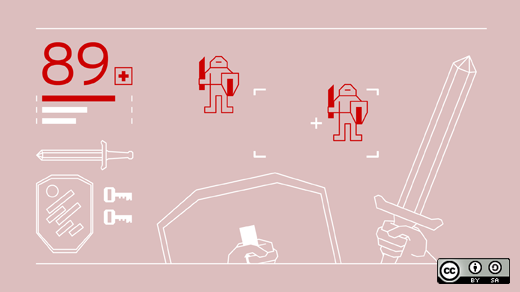The only way to truly beat Hack 'n' Slash, a new video game from Double Fine Productions, is to reprogram it.
But playing the game—a sendup to traditional adventure games like The Legend of Zelda, which place players on quests that involve battling monsters, collecting artifacts, and solving puzzles—requires no programming knowledge whatsoever. Nor does it demand familiarity with coding tools. Instead, Hack 'n' Slash makes manipulating the game's source code part of the game itself. To play it is to hack it.
In a recent interview with Wired, Hack 'n' Slash creator Brandon Dillon stressed an affinity between computer programming and video gaming. Coding, he said, "is just puzzle solving," and "anyone who engages with a puzzle action game like Zelda—they’ve already got the skills to understand all this."
So he designed a video game that makes programming a core gameplay mechanic.
"It borrows the aesthetics of a top-down adventure game, but it's really this puzzle game that teaches you about hacking," Dillon told Polygon.
Here's how it works: Players control protagonist Alice (crypto geeks and cypherpunks will get the joke) as she traverses pastel forests and cavernous dungeons. Along the way, she encounters enemies and puzzles she must dispatch or solve with one of the magical tools at her disposal.
Her primary weapon is a souped-up USB dongle, the Hacking Sword. It doesn't damage baddies as its bladed counterpart might; it plugs into them and gives Alice access to the code that governs them. Players can then manipulate variables in that code to craftily achieve victory. Set the enemy's health value to 0 and it perishes. Configure its damage variable and it can't hurt anything. Reverse its movement properties and it'll run away. In Hack 'n' Slash, players slash to hack. Laura Hudson, who reviewed the game for Wired, gets it: "Where most games like this use code to emulate combat," she writes, "Hack ‘n’ Slash uses combat to emulate code."
Also in Alice's arsenal is the Third Eye Hat, an artifact that launches the game's debug mode (the same tool Double Fine uses to troubleshoot Hack 'n' Slash) and allows players to tweak the game's global variables. Alice can then speed the game up or slow it down. Or she can glimpse enemies' hit boxes and visibility sensors, so she can plan precisely how to engage (or avoid) them.
And Alice can read books—which, Dillon told Wired, "are literal files in the game’s file system. When you modify a book in the game, you’re actually changing one of the files that the game uses." So by cracking the tome about the too-short bridge in front of her, Alice can lengthen it to cross a chasm.
As players become more savvy, Hack 'n' Slash grants them bombs, which open portals into the code of virtually every aspect of the game. Flip one or two Boolean operators, and objects and enemies that didn't bear USB ports suddenly sprout them—and become susceptable to Alice's Hacking Sword.
Dillon hopes Hack 'n' Slash inspires users to think playfully about manipulating code. Video games in particular, he thinks, encourage people to probe the limits of software systems.
"[Hack 'n' Slash] is a way to explore games that is, I think, really empowering and interesting and hasn't really been explored because we build our games to prevent players from doing those things," he said in an extended interview and playthrough with Rock Paper Shotgun. "Hack 'n' Slash is really about inverting that, and making a game that's all about discovery and analyzing what's going on at a deeper level and modifying those things."
Hack 'n' Slash debuted on cross-platform cloud gaming service Steam earlier this month. It costs $20, one property that—at least for the moment—players can't alter.







2 Comments